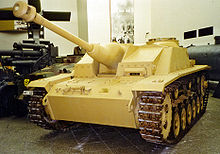Sturmgeschütz III
It was built on a slightly modified Panzer III chassis, replacing the turret with an armored, fixed superstructure mounting a more powerful gun.Initially intended as a mobile assault gun for direct-fire support for infantry, the StuG III was continually modified, and much like the later Jagdpanzer vehicles, was employed as a tank destroyer.[4] The Sturmgeschütz originated from German experiences in World War I, when it was discovered that, during the offensives on the Western Front, the infantry lacked the means to engage fortifications effectively.The artillery of the time was heavy and not mobile enough to keep up with the advancing infantry to destroy bunkers, pillboxes, and other minor fortifications with direct fire.The initial proposal was from von Manstein and submitted to General Ludwig Beck in 1935, suggesting that Sturmartillerie units should be used in a direct-fire support role for infantry divisions.On 15 June 1936, Daimler-Benz AG received an order to develop an armoured infantry support vehicle capable of mounting a 7.5 cm (2.95 in) calibre artillery piece.The gun mount's fixed, fully integrated casemate superstructure was to allow a limited traverse of a minimum of 25° and provide overhead protection for the crew.The Panzerwaffe (armoured corps), the natural user of tracked fighting vehicles, had no resources to spare for the formation of StuG units and neither did the infantry.As the StuG was designed to fill an infantry close support combat role, early models were fitted with a howitzer-pattern, low-velocity 7.5 cm StuK 37 L/24 gun, similar to those used by the earliest versions of the fully turreted Panzer IV.Low-velocity shells are lightly built of thin steel and carry a large charge of explosive, to destroy soft-skin targets and blast fortifications.The Sturmgeschütz III-series of vehicles proved very successful and served on all fronts, from Russia to North Africa and Western Europe to Italy, as assault guns and tank destroyers.In Italy, the Sturmgeschütz was highly valued by crews fighting Allied armour, but was dogged by mechanical unreliability; particularly the delicate final drive units.Post-WWII, these were used for a short time before being turned into fixed gun emplacements on the Krali Marko Line on the border with neighbouring Turkey.StuG IIIs were also given to the pro-German Croatian Ustaše Militia, most of which were captured in Yugoslavia by Tito's Yugoslav partisans during and after the war, as did German-operated vehicles.A few Syrian StuG IIIs ended up in Israeli hands and became war memorials or were simply left rusting away on former battlefields.Twenty-four were rebuilt on older StuG III chassis of which twelve vehicles saw combat in the Battle of Stalingrad, where they were destroyed or captured.To make up for this loss of production, Krupp displayed a substitution StuG on a Panzer IV chassis to Hitler on 16–17 December 1943.Field modifications were made to increase the vehicle's survivability, resulting in diversity to already numerous variants; cement plastered on front superstructure, older Ausf.C/D retrofitted with a KwK 40 L/48 gun, Ausf.G mounting Panzer IV cupola, a coaxial MG34 through a hole drilled on a boxy mantlet, et cetera.[8] In total, Factory #37 in Sverdlovsk manufactured 181 SU-76i plus 20 commander SU-76i for Red Army service by adding an enclosed superstructure and the 76.2 mm S-1 tank gun.








Assault gunNazi GermanyWorld War IIWar over WaterSix-Day WarYom Kippur WarAlkettℛ︁ℳ︁Armour7.5 cm StuK 40 L/487.92 mmMaybach HL120 TRMgasoline enginetorsion barGermanyfully trackedarmoured fighting vehicleSd.Kfz. 251half-trackPanzer IIIJagdpanzertank destroyerSturmgeschützWorld War IWestern FrontinfantryErich von MansteinLudwig BeckDaimler-Benzcasematemild steelhowitzer7.5 cm StuK 37 L/24German ArmyPanzerwaffePanzer IVSoviet7.5 cm StuK 40 L/43Baltic OperationTiger IPantherFinnish ArmyRomaniaJagdpanzer IVsUstaše MilitiaTito'sYugoslav partisansYugoslav People's Army8.8 cm Flak 37Armored Division "M"BlackshirtsItalian ArmisticeSoviet UnionBreda-SAFAT machine gunFiat G.55T-34-85sthe War over WaterGolan HeightsBattle of Franceshot trap7,5 cm StuK 40 L/48muzzle brakesbattle of KurskUSAAF bombing of Schweinfurtmachine gun holeZimmerit10.5 cm leFH 18muzzle brakeflamethrower15 cm sIG 33Sturm-Infanteriegeschütz 33BBattle of Stalingrad23rd Panzer DivisionStuG IVSU-76iSverdlovskRed ArmyNormandycatastrophic internal explosionWarsaw UprisingSyrian ArmyYad La-Shiryon Tank MuseumKingdom of RomaniaKingdom of BulgariaFinlandCzechoslovakiaBanská BystricaSlovakiaFranceKingdom of HungaryKingdom of ItalyNorwayCartagena, SpainSwedenSFR YugoslaviaWar and Peace RevivalJon Phillips Private Armor CollectionParola Tank MuseumHistórico Militar de CartagenaAmerican Heritage MuseumSchweizerisches Militärmuseum FullDeutsches PanzermuseumPatriot ParkMusée des BlindésThe Australian Armour and Artillery MuseumKubinka Tank MuseumYad La-ShiryonBelgrade Military MuseumThe Wheatcroft CollectionThe Tank MuseumBovington CampMuseum of the Great Patriotic War, MoscowBundeswehr Military History MuseumNational Museum of Military HistoryOverloon War MuseumAuto + Technik MuseumCastiglion FiorentinoGeneral Military AcademyMaasotakouluHaminaKarelia BrigadeKhmeimim Air BaseThe Royal Tank MuseumSaratovU.S. Army Armor & Cavalry CollectionPatton Museum Of Cavalry And Armor